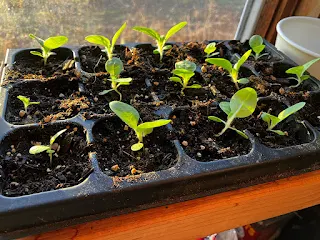 |
| Nicotiana seedling update. Picture taken March 18 |
 |
| Nicotiana seedlings. Picture taken March 11 |
I dug the last few holes for replacement fruit trees in the Upper Orchard at The Property. I thought I had six to replace in the last row but two of the 'empty spaces' had fruit trees. One was a sucker from a root-stock and other was a puny, spindly, shade-stunted pear. I left the one that were there and only dug four holes.
It is my habit to take a walk about whichever orchard I will be working on before I dive in and tackle the task I have planned for the day. I was distressed to find some newly girdled apple trees. I don't think that I missed them the last time I was in the orchard. I took the appropriate precautions and will go back today and care for the stripped bark.
I was distressed to see that the "tree tubes" seemed to favor young trees being attacked by mice.
The current plan for the new trees will be to take 24"-by-36" pieces of aluminum window screen and wrap the trunks with it. Since that will be much bigger than required, it will wrap around several times and if I "crimp' it with my hands it will not unwind. I will not tie it. I want it to expand as the tree grows. That should be enough to deter both mice and rabbits.
Laying out orchards
It is my habit to think in terms of "sun coordinates" when planning orchards.
Since I live at 42.5 degrees North, the sun is south of straight-up at noon. That means that if I plant short trees north of taller trees, the short trees will be in the shade. Fruit trees in the shade make less fruit, and fruit of lower quality than trees that get full sun. (This might not be true in the desert).
Another point to consider is that morning sun dries off the dew and reduces the risk of mildew and other fungal diseases destroying the leaves. Planting taller trees east of shorter trees handicaps the shorter trees. Fewer leaves catching the sunlight means less fruit and lower quality fruit.
A third point is that cold air puddles in lower areas. Fruit species that bloom earlier in the spring want to be planted up, out of those puddles.
On the site for Southern Belle's orchard, the east end is slightly higher than the west end.
At this time, three rows are planned, running East-West and they currently five trees long.
I got three of the hazelnut bushes planted today.
The southern-most row, from East-to-West:
- Cresthaven Peach
- GoldRush Apple (The least vigorous apple variety)
- Liberty Apple
- Liberty Apple
- Chojuro Pear (Note: Pears are on less-dwarfing root-stock than the apples. Chojuro is the least vigorous pear variety of those planted)
Middle row, from East-to-West
- Contender Peach
- Melrose Apple
- Fuji Apple (The most vigorous apple variety)
- Harrow Sweet Pear
- Kieffer Pear (The most vigorous pear variety)
North row, from East-to-West
Yamhill Hazelnut (Does NOT have complete resistance to Eastern Filbert Blight)
Yamhill Hazelnut
Jefferson Hazelnut (Does NOT have complete resistance to Eastern Filbert Blight)
Somerset Hazelnut (So far, no evidence of EFB)
Grand Traverse Hazelnut (the tallest variety, strong (but not total) resistance to EFB)
Then, about 25' west of the Grand Traverse, to plant a grafted mulberry.]
There you go actually using science and common sense. Stop that!!! :-)
ReplyDeleteKudos on your successful arboriculture! Great to see your overall plan and why you've chosen those varietals. Any other fruit or nut trees in the near future? Wondering about plum and pecan for example.
ReplyDeleteFrom part time snowbird
ERJ, you've broken the internet! I went Victory Seed to order some Nicotiana seed and got a 404 page saying their payment processor no longer allows them to sell the seed as of March 10th. They are moving to a new processor and say they will have them offered again soon.
ReplyDeleteThis whack-a-mole is getting ridiculous.
Can't stop the signal though.
Neck